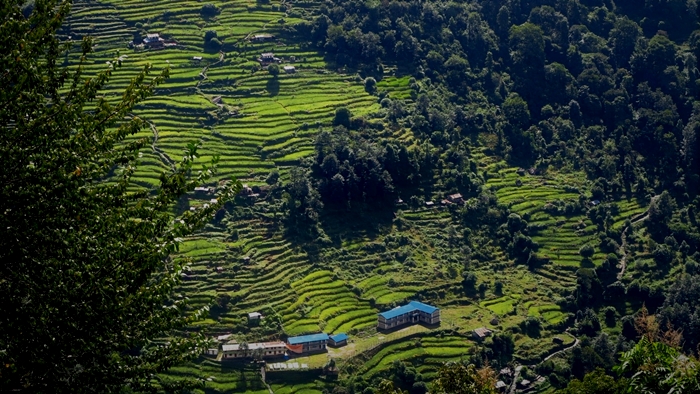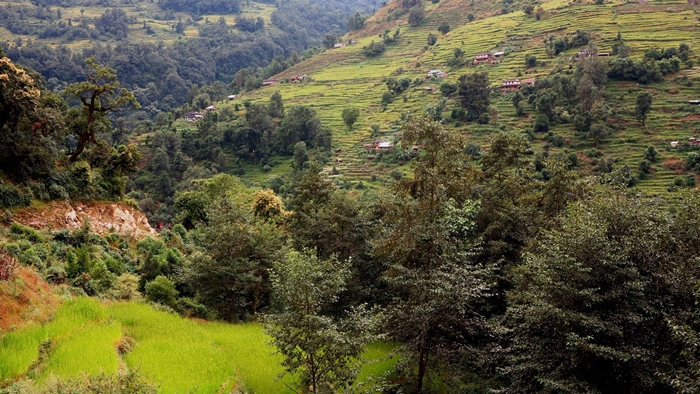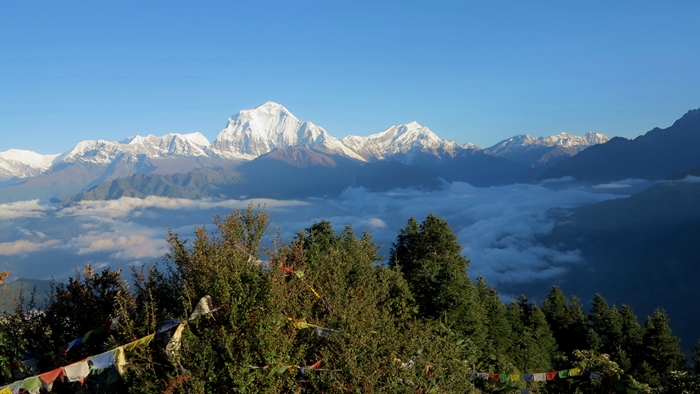My little mountain expedition had not been difficult to organize. I had opted for a route considered easy compared to the usual ones in the Himalayas: it would have lasted five days, and it would not have taken me higher than ten thousand feet. Most importantly, it would have offered me unforgettable views of the Annapurna massif.
The receptionist at the hotel in Kathmandu had offered to take care of everything. I told him I needed someone to show me the way up the mountain and help me with the rucksack, so he found a Sherpa for me. According to the description, the man could act as both guide and porter. I was supposed to meet him the morning before starting the trek.
Instead, the guy who showed up at my hotel did not seem to have reached full age, although he claimed so. When I saw the pair of cheap plastic slippers that he was wearing, it was already too much for me. This was how he was planning to trek in the Annapurna, and carry our luggage, too?
The way my so-called guide presented himself was, to my eyes, a fragrant violation of all the mountaineering rules ever known. I pointed out to the kid that I wouldn’t let him come in slippers, so he’d better find some hiking boots. Otherwise, I had the feeling that I was the one who had to take care of him, not vice versa!
After a few seconds, however, I felt like biting my tongue. My maternal and educational impulse had made me omit a probability that, in Nepal, was not to be ruled out at all: maybe the poor guy didn’t have any boots!
Unsure about how to solve the dilemma, I asked him:
“Do you have hiking boots at home or do you need to get some?”
“Okay,” he replied.
I realized he didn’t understand English. I asked him a control question:
“What time does the bus leave?”
To which he answered, monosyllabically, but still smiling:
“Yes!”
Now it was all clear. I was going up the mountain with a teenager who had no proper equipment and didn’t even understand what I was saying!
I called the hotel immediately to tell them I couldn’t leave under such conditions. They explained that I had no reason to worry, and that the boy knew the trail very well. However, if I wanted a guide with whom to have conversations in English, it was a whole different story. A different job for a different price. But that too could be arranged.
Eventually, we agreed on the guide. My heart wouldn’t have let me fire the kid. As arrogant as it may have seemed for me to have two employees just for myself, in Nepal I had quickly learned not to regret any money I would spend on people.
The guide came wearing proper boots and carrying a small backpack. His name was Sunil. About forty years of age, he was short and stocky, with a gentle yet reserved expression on his face.
To get to the starting point of our trek, we had to use public transportation. That journey turned out to be a true epic. The bus was painted in all possible colors and overloaded with luggage, from suitcases to chicken coops. Inside, people were sitting on top of one another, trying to breathe as close as possible to the windows. As for the road, it was the narrowest, the most pitted, and the most dangerously winding I had ever seen in Nepal. We passed steep precipices so tightly that only a few inches, or a few pebbles, were standing between them and the bus. As we went up and away from Pokhara, I could see the city at the foot of the mountains and the waters of the lake shining in the sun, while the snowy peaks of the great Himalayas appeared at the horizon.

From the bus, Sunil pointed to a small house on the side of the road and told me that he lived there.
“Aha, I see it,” I confirmed. “So, this is your house?”
“It’s not my house,” he replied, probably astonished by the sound of my innocent statement. “I don’t have a house. I’m staying in a room.”
He had a wife and two daughters, and they all lived in one room. Like many other Sherpas I would meet in the days to come, he relied on mountain expeditions to support his family.
After the adrenaline rush provided by the local bus, it was finally time to move our feet. The path started at a relatively low altitude, on the edge of a river, and ascended smoothly over wooded hills. It was quite hot and humid, so I felt my face burning even before making any physical effort. But it would only be a short day’s walk, given the many hours spent on the bus.
Sunil was by my side all the time, answering my questions, giving me advice, or simply telling me various stories from his experience as a guide. He picked the accommodation and ordered food for me, leaving me nothing to worry about. I perceived his presence like a genuine privilege.
The kid had come in sneakers, but that was only to please me, because he didn’t wear them for too long. He put back his slippers as soon as he was out of my sight. I didn’t insist, thinking that maybe the sneakers were new or he had borrowed them and he wasn’t feeling comfortable in them. Anyway, he literally flew past us. He was walking so fast that he reached our destination in half the time it took me to get there. In contrast with other porters, who carried large and heavy luggage, he frolicked happily with my meagre backpack, which I had emptied of everything that was not strictly necessary, leaving the rest at the hotel in Pokhara. He was very cheerful, laughing and singing happily all the time. Whenever we would meet on the way, at some stop where he waited for us, he would wave his arms from a distance, smiling from ear to ear, as if I were a very dear relative coming from far away, whom he hadn’t seen for a very long time.
We spent the first night in a small village with narrow stone alleys and whitewashed houses scattered among terraced rice fields. The lodge Sunil chose was clean and welcoming, and the food that the hosts cooked for me was delicious. It was going to be the same everywhere I stayed. As a bonus, despite the altitude, the night temperature was bearable, even for someone as cold-averse as me.

Some lodges had TV sets. Like in Kathmandu, the hosts were often watching Indian soap operas, with the entire family. At my usual dinner time, a TV series about Hindu mythology, very popular with the locals, was broadcast. All screens would display the image of a chubby child with a horn attached to his nose, who played the role of the elephant-headed god Ganesha.
The next day, the hike was longer and more sustained, but the landscape also became more spectacular. We followed a rocky path with steps carved in stone, crossed bridges suspended over fast streams, and went through a few isolated hamlets bordered by thick forests. We often shared the path with donkeys and goats. The higher the altitude, the steeper the slopes, but the vegetation was not getting any less scarce. Although the ruthless steps made my ligaments squeak, they were manageable. It made a big difference that I had trekking poles and no weight to carry. Besides, it was just me and the guide, and I was free to walk at my own pace. I was feeling so grateful that I would not have let the slightest inconvenience spoil the joy of my trip.

At one point, we came across an incredibly large group of tourists, so large that the path was literally packed for dozens of meters. In spite of their number, they had only one Sherpa to guide them. I don’t know if it was for financial or other reasons. In the evening, at the lodge, we heard that a part of that group was nowhere to be found. They had no trekking experience, and very few of them spoke English. At some point, they had misunderstood the guide’s directions, losing their way. Needless to say, the trails in Nepal were not marked.
All the Sherpas in the lodge had to join the search party, leaving aside food and rest. That was how they ended their day, after having walked up and down the mountain in slippers, carrying two rucksacks each, one on their shoulders and the second attached with strings to the first.
I met many Sherpas in the huts, and I gained an endless respect for those people. Their faces were hardened by the winds and snow, but their spirit was always calm and friendly. Without their help and dedication, many attempts to reach the great peaks of the Himalayas would not have succeeded. More recently, they were also responsible for fixing the consequences of mass tourism, which not even the Himalayas had been spared of.
Probably the only time I followed in the footsteps of Sir Edmund Hillary or Tenzing Norgay, the first conquerors of Everest, was when I walked the streets of Thamel. Nevertheless, the stories told by the Sherpas brought the world’ highest peak closer to my imagination, and with an extra dose of realism. While we were chatting by the fire, the Sherpas were complaining that the number of people who came to climb Mount Everest grew every year, despite the $25,000 fee applicable to all those ascending. There was an ever-increasing number of expeditions organized by very rich people, with whole armies of porters and oxygen cylinders at their discretion, even though they were not necessarily able to go very far. At the other extreme were the mountain lovers who claimed out of passion, and who would not have hesitated to compromise their own expedition should they be needed to help rescue others. For the latter, the Sherpas only had words of praise.
Another sad story was that of the garbage that had accumulated on Everest’s peak as a result of the influx of people. The Sherpas were joking that the mountain had become six feet higher because of the debris. Obviously, nothing could not be taken down, because at such altitude, with so little oxygen, the slightest effort could demand one’s life. Tragically, the frozen corpses of those who had died near the top also multiplied every year, with no chance of being brought back…
As soon as we left the populated areas behind, we started to climb through the jungle. The altitude compensated for the excess humidity with a welcome dose of coolness, to which a few waterfalls contributed from time to time. And as the forest thinned to make way for alpine pastures, the snow-capped peaks of the Annapurna massif appeared in the background.

“I don’t think I’ve ever seen anything more beautiful!” I exclaimed in a moment of enthusiasm at the sight of a breathtaking landscape.
Hearing me, Sunil blushed with pride and pleasure.
The combination of alpine terrain and warm climate was, for me, a permanent source of delight. Instead of the barren rocks and sharp cold that I would have expected in other places at an altitude of six or seven thousand feet, I was greeted by lush vegetation and mild temperatures. The meadows were covered with tall grass and flowers, the forests resounded with the song of birds, and the clearings were populated by vividly-colored butterflies the size of my hand. From above, the bright white peaks of the world’s highest mountains dominated the place, like crowns of mighty rulers. With so much greenery around, it was easy to forget the altitude. Only the fog I was seeing in some places reminded me that I was actually above the clouds.
The last night on the route was chilly, but I coped honorably, thanks to my thermal clothes and the thick sleeping bag. It was a short night, because I woke up before daybreak to witness a moment of celestial magic.

At dawn, only the tallest peaks were touched by the sunlight. Then, as the sun rose, the snows on the ridges bathed more and more in the morning light, changing colors from orange-red to bright gold, while the valleys remained covered with deep-green blankets of shadows. That was the reason for which I had set out: the privilege of contemplating the divine Annapurna and Daulaghiri, at the call of the new day, when they blessed with their radiance the land that prostrated at their feet.
Maybe high up there, where there is nothing but stone covered in ice, the mountains become cold and merciless. But that is a realm where only the masters of alpinism and their guardian angels, the Sherpas, could ascend. For ordinary mortals like me, able to reach only modest altitudes, beauty was more accessible than greatness, and admiration more convenient than struggle. This is why the Himalayas remained in my memory, not just as the highest, but first and foremost, as the most beautiful mountains in the world.
